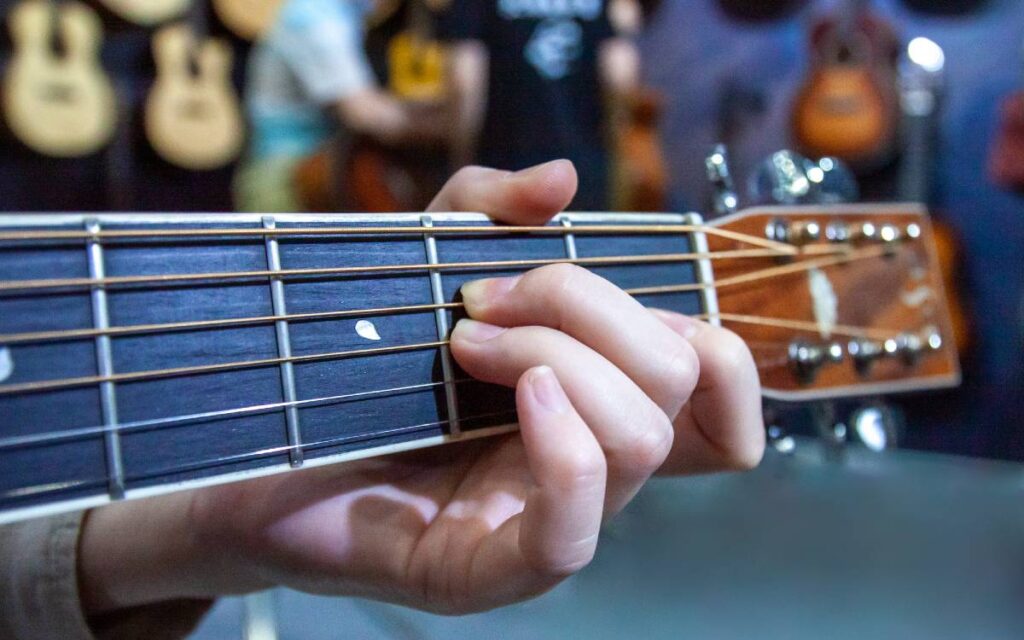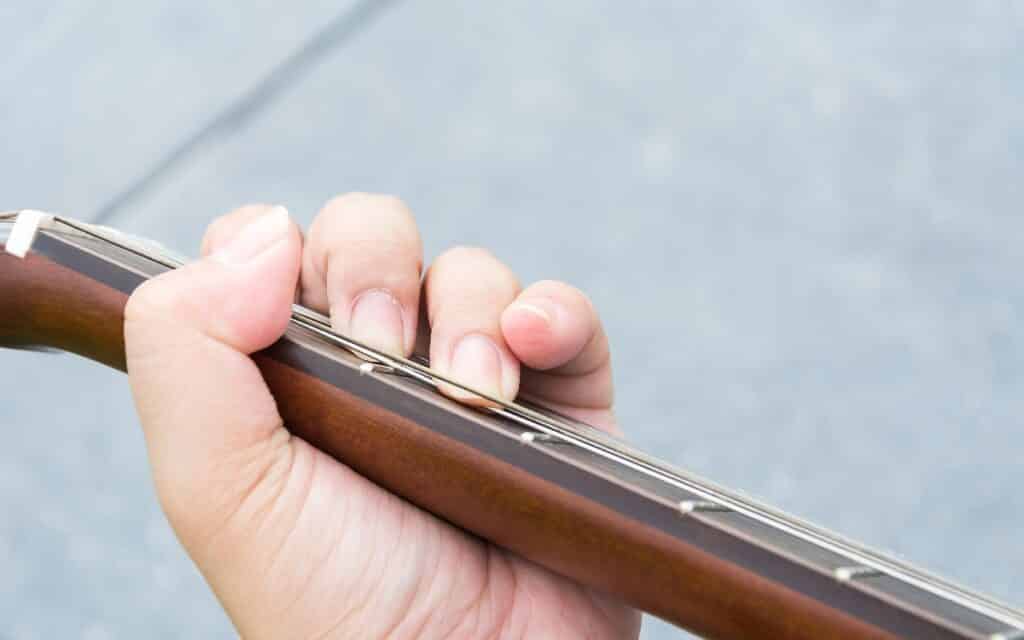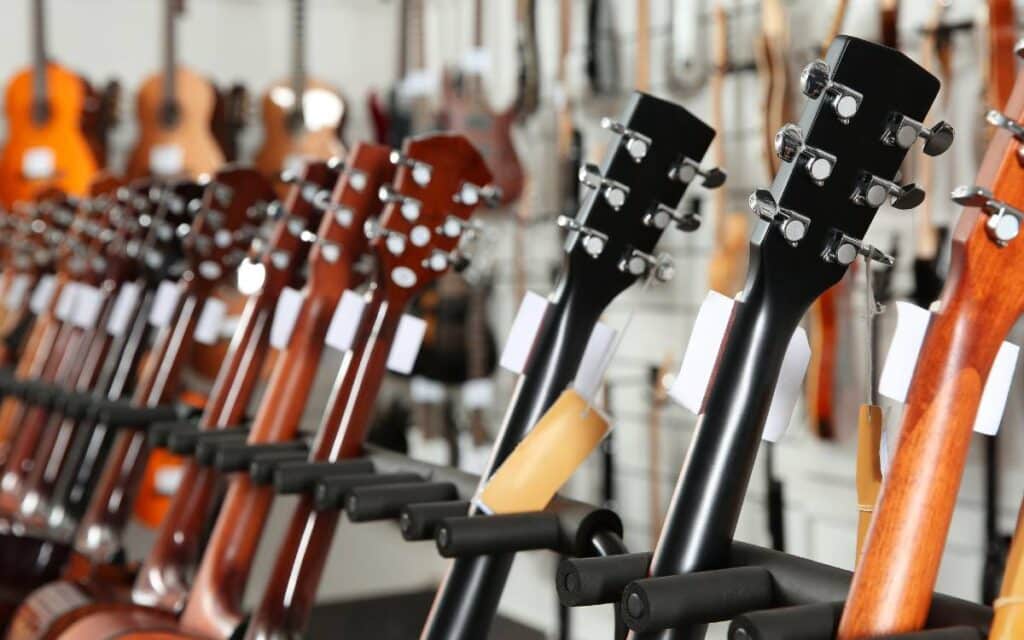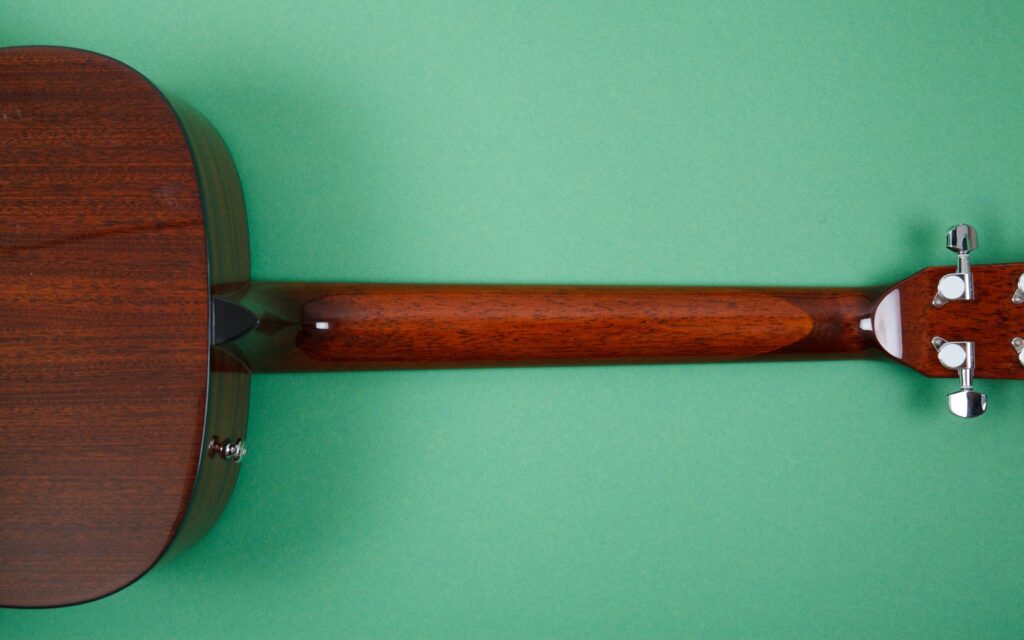There are a wide range of acoustic guitar neck types, with different manufacturers using distinct designs. The most common acoustic guitar neck shapes are C, D, V, and U, while set-necks and bolt-ons are some of the common types. Necks can be thick or thin, and the fretboard radius, width, and depth are significant factors in playability and comfort.
Whether you’re planning to buy a new acoustic guitar or are just curious about your current acoustic’s specifications, guitar neck shapes, sizes, and types is crucial. The guitar neck is where your fretting hand lives, and it needs to be comfortable and ergonomic for your playing style.
We’ve broken down the most common neck types seen on acoustic guitars, so you can choose the one that’s the right fit for you. From shape to size, each tiny detail can make a difference in your playing.
Post Contents
How Does the Neck Affect a Guitar?

The guitar neck is an essential component of acoustic guitar anatomy since it holds considerable tension from the guitar strings and is also where your fretting hand is placed. On acoustics, the neck has a significant impact on the sound, but more importantly it affects playability, comfort, and durability of your guitar.
The guitar neck shape is the curvature of the back of the neck, from the headstock to the body joint.
The neck shape (also called neck profile) is an important factor in playability, as it’s what you’ll grip with your left hand. Players have different preferences for neck shapes, and companies usually make acoustic guitars in a variety of neck shapes to offer you option. We’ll get more into neck shapes further down. Let’s go over sizes first.
Guitar Neck Sizes

Three factors affect how your guitar neck will feel: the depth, the width, and the fretboard radius.
Depth
The depth of your guitar neck refers to its thickness. It measures the distance from the front to the back.
Since acoustic guitars come in several sizes, not all of them have a standard depth. Dreadnought guitars designed by Martin have an average depth of 3-¾ inches to 4-¾ inches.
Parlor guitars, which are the smallest full-sized guitars, have an average depth of 3-1/2 inches. Concert acoustic guitars have a depth of about 4-1/4 inches, and orchestra or auditorium acoustic guitars have a depth of 3-⅛ inches to 4-⅛ inches.
Among larger guitars, the jumbo acoustic guitar can reach depths of 4-⅞ inches, while the modern classical guitar could be 3-¾ to 4 inches deep.
Width

The width of your guitar is the measurement from one side of the neck to the other. Most luthiers and companies measure the width at the nut of the guitar. This also affects the string spacing (the gap between any two consecutive strings).
Guitars come in various widths, and the standard classical guitar can be as wide as 2 inches! Standard steel sting acoustic guitars tend to have a neck width between 1.61 to 1.75 inches.
This is meant to be a comfortable neck width for most guitarists, but you should always hold the guitar in your hand and check if it feels suitable to you.
Fretboard Radius
The fretboard radius is the measure of the arc of its width. Very few guitar necks are genuinely flat, and most are slightly convex along the width.
The classical guitar has a flat fingerboard, so the fretboard radius isn’t a variable you need to worry about as a classical guitarist. However, fretboard radius is a vital playability factor for other acoustic guitarists.
The fretboard radius, much like the neck shape, is also supposed to fit the curvature of the human hand and make it comfortable for the player. In numbers, a smaller radius (like 12”) is more curved than a larger one (such as 20”).
Unless you’re a pro fingerstyle guitarist and frequently bend your strings, a good rule of thumb to follow is that a more curved neck is easier to hold due to the natural curve of the human hand. But at the higher frets, a flat radius becomes more comfortable for solo guitar.
Even though there are generalizations that flatter necks are better for fingerstyle guitarists and curved necks are better for chording, it is always best to go to a shop and choose a guitar that feels the most comfortable in your hands.
While all these numbers might sound confusing if you haven’t played a lot of guitars, it goes to show that multiple factors affect playability. Manufacturers experiment with a lot of different neck shapes, depths, widths, and fretboard radii. And they all come together to form a well-playable neck – which of course differs from player to player.
Thin and Thick Guitar Neck Shapes – Pros and Cons

Guitar necks could be thick or thin, and each has its advantages/disadvantages that players prefer. The thickness of a neck generally refers to its depth, but sometimes its width (at the nut) as well.
Thin Neck Shapes
Several brands like Yamaha, Ibanez, and Takamine make acoustic guitars with thin necks, almost akin to electric guitar necks (which are known to be slightly thinner).
If you feel a thin neck shape is what suits you best, you’ll probably find that it is much easier for you to play fast. Your thumb might not even touch the neck when you’re speeding through quick scale runs, and you’ll have easier contact with the fretboard.
However, a thin neck shape comes with its drawbacks as well. Holding big chords may feel a bit awkward since you don’t have a thick grip. Owing to their low radius, they lose their shape much faster; this means that you will have to take utmost care of your instrument between seasons and with changes in humidity.
Getting a sturdy neck with a good truss rod helps in these cases, but drives the price up. Repairing a misshapen neck can also be a pain, often costing a hefty amount at repair shops.
Thick Neck Shapes
While it’s true that thick neck guitars offer some protection from the warping that thin neck guitars go through, whether they’re better is entirely subjective and a personal preference.
The most prominent con of wide-neck guitars is the sheer size of their necks. If your hands are smaller than average, you might face issues getting around your guitar’s fretboard. You ideally want to be able to comfortably hold your guitar while also moving through all the frets.
However, if you’re playing a lot of barre chords, a thick neck might suit your playing style better. Just make sure the fretboard radius is comfortable enough to allow you both grip and mobility, and you’ll be good to go.
The Types of Guitar Necks You Might Find

Bolt-On Necks
Before we get to neck shapes, we need to talk about the construction of the neck with respect to the rest of the guitar body. Bolt-on necks are on the cheaper end, but they are often interchangeable since they are, as the name suggests, bolted onto the guitar body.
Repairing bolt-on necks is a breeze since it mainly involves taking the bolts out and replacing the neck itself. These necks give a snappier tone and sound almost “twangy”, but a poorly-made bolt-on can make it harder for players to reach the upper frets.
Taylor has a patented design on their bolt-on acoustic guitars, which use three bolts to fasten the neck to the body. Modern guitars usually feature more stable bolt-on necks than older models.
Set Necks
The set neck guitar construction glues the neck of the guitar to the body in a dovetail joint, offering great tones and warm sustain. The sustain you find in set-neck guitars is usually better in comparison to bolt-on guitars, where the gap between the neck and the body does not allow much sustain from the instrument.
Although they’re comfortable to play and sound great, set neck guitars do have some cons. When it comes to repairs, these guitars need to be taken to professional luthiers, and if they cannot solve the problem, you might have to replace the guitar entirely.
The neck shape of set-neck guitars cannot be changed, as opposed to bolt-on neck guitars. This makes these guitars a one-time investment, which means that you will need to pay close attention to how the guitar feels in your hands.
Most acoustic brands, including Martin, Fender, and Yamaha, typically use set necks as their construction process is well-established compared to bolt-on necks.
Which Neck Joint is Better?
Bolt-on necks vs set necks or dovetail necks is a contentious debate in the acoustic guitar world.
Dovetail adherents claim that the sound and sustain is just better due to greater neck-to-body contact. Bolt-on enthusiasts claim that modern bolt-on necks sound just as good, and they’re far easier to fix if you ever need a neck reset.
The differences are debatable, but it is a fact that there are great guitars with each type of neck joint. Our advice to go with the one that sounds and feels the best to you, regardless of neck joint.
The Common Acoustic Guitar Neck Shapes

C-shaped Necks
C-shaped necks are the most common necks found on both acoustic and electric guitars. They have a comfortable shape that fits most hands and suits almost all playing styles.
C-shaped necks are not as deep as U-shaped or V-shaped necks, and many guitar companies, including Fender and Martin, feature the “modern C-shape,” which is modified to be flatter than the traditional C-shape. This allows more flexibility for both fingerstyle and chord playing.
D-shaped Necks
D-shaped necks get their name from their cross-section, which is in the shape of a “D.” These necks are usually seen on archtop guitars and have a more vintage look to them.
They offer great comfort for those with smaller hands but can be difficult to grip for those with larger hands. D-shaped necks are not as popular as C-shaped necks, but they offer better grip and comfort for those who prefer them.
V-shaped Necks
The V-shape comes in two more styles – the softer “rounded” V-shape and the more angular “hard” V-shape (found mostly on vintage guitars). The softer shape suits players with smaller hands, who may need to use their thumbs on the fretboard, while the more point-hard V-shape suits players who do not mind having their thumb hanging over the fretboard.
Since they have grown out of fashion, you may find it challenging to find a V-shape neck on modern acoustic guitars. They show up on several re-issued and refurbished acoustics, so if you manage to find a V-shaped Taylor, consider yourself lucky!
U-shaped Necks
These necks are sometimes called “baseball bat” necks and show up on specific Fender guitars. You might find the rounded U-shape neck ideally suited for your frame if you have large hands. These guitars are also perfect for players who frequently use power and barre chords since they support the thumb on the back or side of the neck.
While it may be a little difficult for newer players to grasp, the neck shapes used by different manufacturers often have their own names, like ‘Oval’ or ‘Low Profile’. Martin has evolved its own neck shapes over the years, as demonstrated in this video:
We would suggest you pick and choose a guitar with a neck profile that fits the curve of your hand after trying them out.
How Do I Find Out My Guitar’s Neck Shape?
If you already own a guitar that seems to fit your hands and feels comfortable when you play for long hours, you might be wondering what neck shape your guitar has. Merely looking at your guitar might not suffice since the exact curve of your guitar might not be evident at first.
If you know the exact model of your guitar, you could look it up online. But if you’re not sure, you can check visually.
One method to find out the shape of your guitar neck is to hold a thread or cable against the neck of your guitar. Once you’ve secured it, you can look down the back of your guitar from the headstock and get an idea about the shape of your guitar’s neck.
Once you have a rough mental idea, you can compare the shape of your guitar’s neck to the above diagram to find out the exact shape.
Most acoustic guitar necks sit between two different neck shapes. There is no set standard about the shape of a guitar neck, so manufacturers take liberty in building a guitar whose neck should fit the vast majority of players.
The labels and shapes mentioned here are rough guides on how guitar neck shapes look to give you an idea about which neck should best suit the curve of your hand and your playing style.
But by knowing which shape you find most comfortable on a guitar, you can narrow your search and look for guitars with specifications that match your preferences. This will make it easier to find one that’s perfectly suited for your playing.
How Do I Choose The Best Neck Shape For Me?

Now that you know a little about the standard neck shapes for acoustic guitars, the obvious question to ask would be which guitar neck shape suits you. Unfortunately, there is no correct answer to that question as it’s almost entirely subjective.
Some generalizations can be made based on the neck shapes commonly used by different kinds of players. The V neck shape suits players who need to move fast between frets and strings, whether that be fingerstyle, barre chords, or acoustic solos.
The U neck shape is almost always most comfortable for people with large hands, and the C shape (the most popular one) tends to suit most players regardless of style or the size of their hands.
So, the best way to figure out which guitar neck shape suits you would be to go to your local music shop, find a guitar that you like within your budget, and sit down to play it for a while. Unfortunately, if your hand starts cramping, the guitar will not suit you. You may have to try out multiple guitars till you find the right one.
If you cannot personally go to the shop and pick out guitars to play, you can always check out YouTube videos and talk to guitarists online to get some advice based on your playing style. Here’s a video that may help you pick a neck shape for yourself:
Regardless, the “play and buy” method will always be undefeated. There’s nothing quite like walking into a store and spotting your dream guitar, and being able to play it before buying it.
The neck of your guitar can make or break the playing experience. Learning the various neck shapes available, trying them out, and seeing what fits your hand and feels comfortable is essential if you want a guitar that feels perfect in your hands.
Frequently Asked Questions About Acoustic Guitar Necks

Are wide neck guitars easier to play?
Yes, wide neck guitars are easier to play for some people, especially if you have large hands. Wide neck guitars allow more space between each string, making it easier for the player to play chords. You’re also going to be less likely to accidentally mute adjacent strings.
However, wider necks can sometimes be tricky, since they require your to stretch out your fingers to reach the necessary strings for your chord or note. Some players prefer wide necks because of their durability and ease of maintenance, while others do not.
What is the best neck shape for small hands?
Small hands do best with C or flat C-shaped necks. However, the neck shape alone is not enough to determine whether it will suit the size of your hands – you also need to consider the fretboard radius and depth.
Small hands make it difficult to span the entire fretboard of the guitar. Deeper necks might make fretting difficult since most of your handspan will be utilized in grabbing the neck, leaving little space for your fingers to reach the fretboard. A curved fretboard should make it easier for you to stretch your fingers across the frets.
Even if you do have small hands, you might find it more practical to invest in a guitar with a flatter and slightly wider neck. These guitars should make it easy for you to reach all strings and span the entire fretboard, and they might not need as much maintenance as thin neck guitars.
Is a thin neck guitar easier to play?
In general, thin neck guitars make it easier for players to reach the lower strings with their fretting hand. A guitar with a thin neck should feel more comfortable than a guitar with a thick neck if you have small hands, and also if you want to play very fast sequences.
However, thin necks come with their own minor cons – you’re going to have to take extra care of your guitar if you live in an area with significant climate changes. Since a guitar is made of wood, the thin neck would expand and contract with temperature and humidity changes, which could end up warping the shape of the neck and the body of your guitar – leading to costly repairs.
Are electric guitar necks the same as acoustics?
Electric guitar necks do often have the same basic design as acoustics, but in general they are a bit thinner. You’ll find the usual shapes – C, D, V, and U, as well as bolt-ons, and set-necks. Neck-thru designs are also often seen in electrics.
But since acoustics don’t play a role in an electric guitar’s sound, you’ll find that there’s a variety of unique neck shapes, such as Strandberg’s EndurNeck, or even double-necked or triple-necked electrics. The materials used also differ, with some guitars using composite ad synthetic materials instead of wood.






